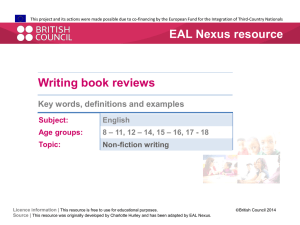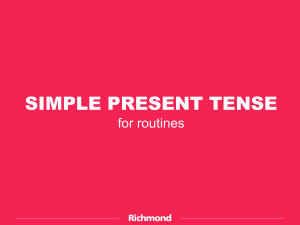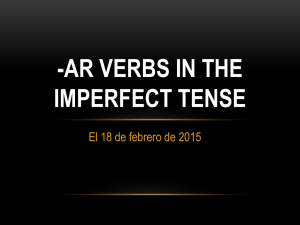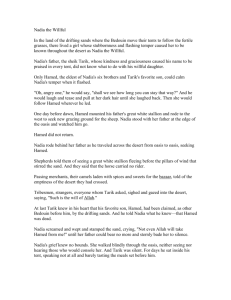II. Verb Tense
advertisement
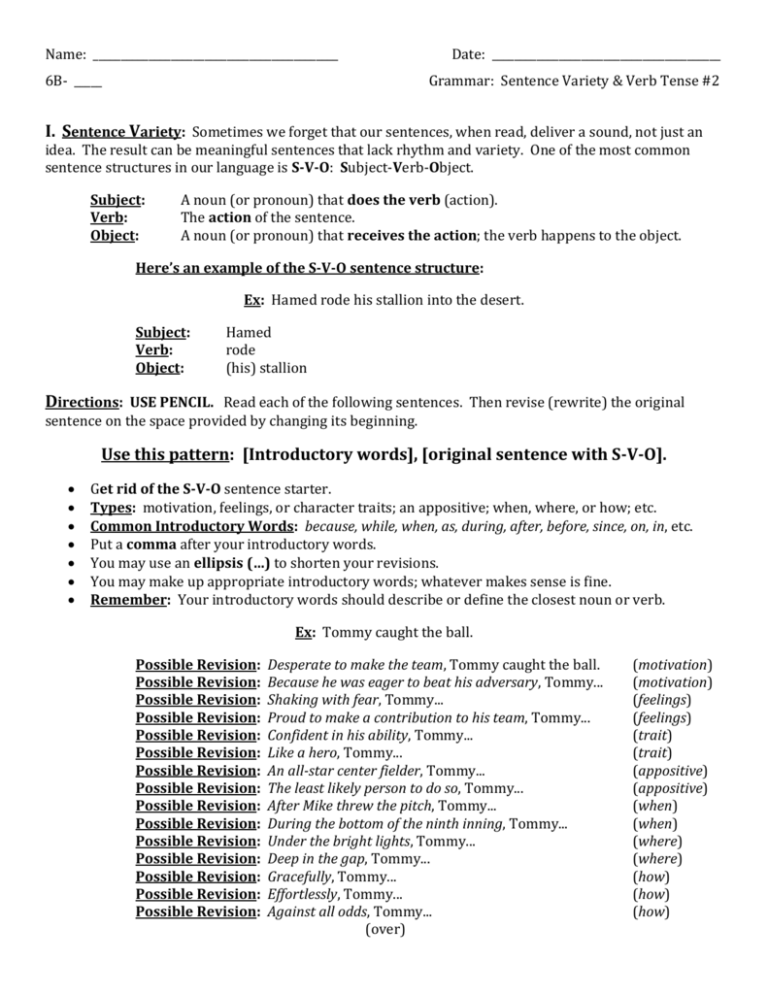
Name: ____________________________________________ 6B- _____ Date: _________________________________________ Grammar: Sentence Variety & Verb Tense #2 I. Sentence Variety: Sometimes we forget that our sentences, when read, deliver a sound, not just an idea. The result can be meaningful sentences that lack rhythm and variety. One of the most common sentence structures in our language is S-V-O: Subject-Verb-Object. Subject: Verb: Object: A noun (or pronoun) that does the verb (action). The action of the sentence. A noun (or pronoun) that receives the action; the verb happens to the object. Here’s an example of the S-V-O sentence structure: Ex: Hamed rode his stallion into the desert. Subject: Verb: Object: Hamed rode (his) stallion Directions: USE PENCIL. Read each of the following sentences. Then revise (rewrite) the original sentence on the space provided by changing its beginning. Use this pattern: [Introductory words], [original sentence with S-V-O]. Get rid of the S-V-O sentence starter. Types: motivation, feelings, or character traits; an appositive; when, where, or how; etc. Common Introductory Words: because, while, when, as, during, after, before, since, on, in, etc. Put a comma after your introductory words. You may use an ellipsis (…) to shorten your revisions. You may make up appropriate introductory words; whatever makes sense is fine. Remember: Your introductory words should describe or define the closest noun or verb. Ex: Tommy caught the ball. Possible Revision: Possible Revision: Possible Revision: Possible Revision: Possible Revision: Possible Revision: Possible Revision: Possible Revision: Possible Revision: Possible Revision: Possible Revision: Possible Revision: Possible Revision: Possible Revision: Possible Revision: Desperate to make the team, Tommy caught the ball. Because he was eager to beat his adversary, Tommy... Shaking with fear, Tommy... Proud to make a contribution to his team, Tommy... Confident in his ability, Tommy... Like a hero, Tommy... An all-star center fielder, Tommy... The least likely person to do so, Tommy... After Mike threw the pitch, Tommy... During the bottom of the ninth inning, Tommy... Under the bright lights, Tommy... Deep in the gap, Tommy... Gracefully, Tommy... Effortlessly, Tommy... Against all odds, Tommy... (over) (motivation) (motivation) (feelings) (feelings) (trait) (trait) (appositive) (appositive) (when) (when) (where) (where) (how) (how) (how) 1. The Bedouin people inhabit the Arabian Desert. _________________________________________________________________________________________________________________________ 2. Nadia violates Tarik’s law. _________________________________________________________________________________________________________________________ 3. Tarik banishes the shepherd to the desert. _________________________________________________________________________________________________________________________ 4. The tribe honors Nadia throughout the oasis. _________________________________________________________________________________________________________________________ 5. The desert sands engulf Hamed and his stallion. _________________________________________________________________________________________________________________________ II. Verb Tense: Verbs do all sorts of things, but they usually show action. Action verbs have tenses, or times. The main tenses are past, present, and future. When you write, you should generally stick with one verb tense throughout your writing. For creative stories, most writers use past tense (was, ran, thought, etc.), which suggests that the action already happened. For essays about stories, however, most writers use present tense (is, runs, thinks, etc.), as if the action is “live” in the present. The point, no matter what mode you’re writing in, is to use the same verb tense throughout your writing, to keep your action in one tense from start to finish. Directions: USE PENCIL. Let’s make all the verbs in this paragraph appear in the PRESENT tense. First, circle all of the verbs. Note: A sentence can have more than one verb… Next, cross out verbs that are in the past tense. Finally, turn past tense verbs into PRESENT tense verbs by carroting in (^) your correction. Sometimes verbs come in groups/verb phrases: helping verb + verb. (Ex: Tarik was crying.) Linking verbs can stand alone: WASABI: was, were, am, is, are, be, being, been. (Ex: He is sheik.) Sometimes, a verb has to be something other than present tense to make sense. This is OK. The author introduces the theme when the tribe responded to their horrible loss. In the Arabian Desert, quick-tempered Nadia and her “kind and gracious” father, Tarik, the sheik of her tribe, lost their beloved family member Hamed. After this tragic death, the narrator described their reactions: “Nadia screamed and wept and stamped her feet, crying, ‘Not even Allah will take Hamed from me!’ ” Equally upset, Tarik decreed, “From this day forward… let no one utter Hamed’s name. Punishment shall be swift for those who remind me of what I have lost.” In effect, Hamed’s death changed Tarik as soon as it happened; he became unpredictable like the desert that killed his son. His law was not kind or gracious; it showed Tarik only thought of himself, even though the whole tribe was suffering. Even worse, Tarik forced his solution onto his tribe. He went into the first stage of grief, denial, immediately after the loss, and he made his tribe do it too. In a way, Tarik and Nadia were both in denial but for different reasons. Tarik denied the fact that Hamed ever existed. On the contrary, Nadia was denying the fact that Hamed was actually dead. Willfully, she challenged the power of her god because she couldn’t, or wouldn’t, accept her loss.




